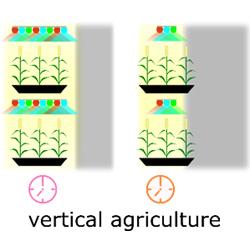Supervisor
Professor Alex Webb (Department of Plant Sciences) and Dr Jen Bromley (Vertical Future)
Brief Summary
LED lighting technologies have facilitated a new kind of farming in which foods are produced in indoor environmentally controlled facilities, known as vertical farms. These facilities can produce food in cities and in the future in off-Earth growth facilities. However, modern crops are not optimized for growth indoors and therefore there are opportunities to improve the production of these new crops.
Importance of Research
We will use the new field of chronoculture, a practice in which knowledge from circadian biology is used to improve crop production, to increase the sustainability of crop production in indoor growth facilities.
Project Summary
Indoor growth, such as vertical farming can contribute to production and sustainability by providing locally produced, pesticide-free food to cities, and in the future life in space. However, energy costs can make the use of indoor growth economically and environmentally expensive. The costs arise from providing indoor lighting and cooling. Because indoor growth is totally environmentally controlled, for the first time in history it is possible to engineer both the environment and the crop to match the farmers’ needs. In theory maximum productivity and reduced engineering costs can be achieved by growth in constant light. However, in practice most species do not grow well in constant light because there is a mismatch between the external environmental and the internal circadian oscillator (Dodd et al., 2005 Science 309, 630 – 633). Working with Dr Jen Bromley at Vertical Future we will investigate ways of improving the growth of crops in constant light. We do not know if growth in constant light affect plants due to constant photosynthesis or whether this is a result of the plant not having 24 h rhythms that are usual for plants growing in a light and dark cycle. We will investigate whether growth in constant light can be improved by inducing 24 hour cycles of activity in the plant using non-light stimuli such as changes in water content and nutrient supply, and by using oscillating light quality and intensity. We will investigate whether this improves growth of lettuce in conditions that promote constant photosynthesis. Similar experiments will be performed in Arabidopsis, both wild type and mutant lines to investigate the mechanistic basis by which constant light affects growth, and the mechanisms by which rhythmic agronomy can improve growth.
What will the successful application do?
The applicant will perform experiments in the Department of Plant Sciences and at Vertical Future’s research facilities aimed at improving growth in indoor farms. The first goal will be to identify if rhythmic treatments of water, light colour and intensity, and nutrient supply in otherwise constant conditions can induce rhythmic behaviour and establish whether this leads to increased growth. Circadian rhythms will be measured using photon counting imaging of luciferase reporters, qPCR of gene expression and measurement of stomatal movements using our recently developed “chronomeasure” temperature sensors. Growth will be measured by image analysis of timelapse capture. The mechanisms by which treatments affect rhythmic behaviour will be investigated in wild type and mutant Arabidopsis. Developed protocols for improving plant growth will be investigated using a range of crops in laboratory and factory conditions.
Training Provided
The successful candidate will receive training in circadian and crop biology, imaging and data analysis. There will also be opportunities for training in industrial practice and wider skills associated with an industrial career.

